I am in a terrific mood this time of year; since late November, actually - because seed catalogues for the coming crop year are appearing in the mailbox!! Remember that I am a speech-language pathologist who uses horticulture in clinical practice. Storing your own seeds in the clinic is having the supply train that assures you - you can do the work that you want! And while cold winds blow, and soil keeps its secrets and treasures locked tight, the gardener is transported in the catalogues to warm, fragrant summertime.
I do understand that very few of us who gardens in their clinical practice have large budgets. That can be overcome. There is also the concern expressed: what do I order? Also, easier than you think. But first, -
* why grow from seed? You have a profoundly rich clinical environment in which to work, over the lifetime of a plant. The mere suspense of waiting for sugar snap peas to germinate; for tomato stems and leaves to morph to their adult form; for dill plants that had gone to flower and then, produce seed - the beginnings of the next generation; - it is the stuff of great communication. Myriads of wonderful interactions with persons you serve can grow out of the garden work you can help conduct.
* how do you find good seed? Experience in the garden seed market is the best teacher. My catalogues for the current year include horticultural household names such as Burpee, Johnny's, Jung, Park Seed, Gurney's and R.H. Shumway. Newer companies such as Natural Gardening Company, Seeds n Such, Vermont Bean Seed, Southern Exposure Seed Exchange, Pinetree and Seed Savers Exchange offer the clinical gardener options of open-pollinated, heirloom and heritage plants. Then there are: Native Gardener's Companion, John Scheepers, Miracle Gro AeroGarden, Seeds of Change, Cook's Garden, Victory, Audubon Workshop, Summerstone, ... whew!!
* How can you afford such a consumable in your annual budget? With some popular seed brands retailing below $1, testing your skill is simple. As you become comfortable with your garden design skills, your budgeting needs grow. It could be an activity fee charged per clinic term, fundraisers, grantwriting, or participation in a community garden that brings you your new budget lines.
The lesson for the novice gardener is : learn by buying a few seed packets from the big companies, and have an initial crop experience. Above all, follow the instructions on the seed packet. Your garden environment, be it container, raised bed or plot, will tell you if your seedlings are a good fit for it.
Are you a good fit for growing plants from seed? Try it and see.

No comments:
Post a Comment